Parasound Halo P 5 Preamplifier Review Highlights
Parasound has updated the Halo P3 after more than a decade with the new Halo P5 preamplifier. With the inclusion of digital processing and bass management, the Halo P 5 is a bargain, competing with preamps costing many times more. Bottom-line, I highly recommend the Parasound P5 for your consideration as an exceptional preamp.
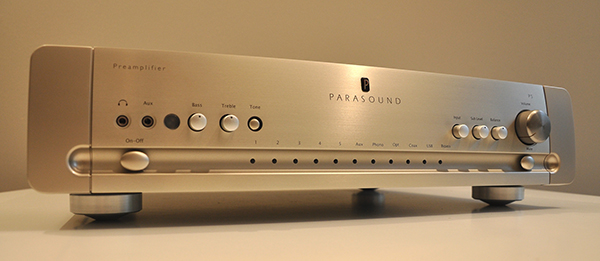
Parasound Halo P 5 Preamplifier Highlights Summary
- 2.1 channels with analog bass management for two subwoofers
- Burr-Brown DAC for digital processing, with input options for USB, coaxial, and Toslink optical
- Home theater bypass, allowing the P5 Preamplifier to be connected in-line in a system for both two-channel listening and home theater.
- Two load settings on the phono stage for MM (moving-magnet) and MC (moving-coil) cartridges.
- Balanced inputs and outputs
Introduction to the Parasound Halo P 5 Preamplifier Review
Calling the new Parasound Halo P 5 simply a preamplifier is an understatement. As expected it naturally handles analog audio in spades, but now the inclusion of digital processing places the P-5 preamplifier in another category. If that weren’t enough, the P 5 provides serious bass management and a headphone amp as well.
PARASOUND HALO P 5 PREAMPLIFIER REVIEW SPECIFICATIONS
- Design: Stereo Preamplifier, Solid State
- Output: 7 Volts RMS Maximum
- MFR: 10 Hz – 100 kHz, – 3 dB
- THD+N: 0.01%
- Input Impedance: RCA – 24 kOhm, XLR – 200 kOhm
- Crossover Slope: 12 dB/Octave
- Dimensions: 4.1″ H x 17.25″ W x 13.75″ D
- Weight: 14 Pounds
- MSRP: $1,095 USD
- Parasound
- SECRETS Tags: Parasound Preamplifier, Parasound P 5 Preamplifier, preamplifier, Stereo, Preamplifier Reviews 2014, Halo Preamplifier
The Parasound Halo P 5 preamplifier replaces the 12 year old P 3. While the flagship JC 2 preamplifier garnishes so much attention, the popular P 3 was well received, hit a perfect market slot at a great price point. SECRETS reviewed the P 3 back in 2002.
Yet when you consider the new P-5 at $1,095 and all the features is virtually unchanged from the elder $800 P 3, considering replacing it with the P 5 is a no-brainer.
Outboard DACs these days seem to be all the rage in the audiophile world as we transition to digital file playback. In the past, compressed digital music had not entered the realm of a serious two-channel world. Not only is digital music gaining momentum it’s becoming the norm. Don’t believe me or think audiophiles aren’t buying into digital music? Attend a high-end two-channel show, CES 2014 or RMAF 2014 for example and see what the exhibitors are using for demonstration, 2-1 it’s sources from their laptops. Perhaps this is for convenience but the quality of high-res files and equipment has them confident in how their gear sounds.
Most quality outboard DACs do offer some form of volume control, multiple digital inputs, and typically at least one analog input, aside from the fact that DACs are digital, literally omitting the relevant phono stage. Does this render the analog two-channel preamplifier obsolete? Never! Up until recently, the sound of a DAC (alone) other than for headphones was well, just too digital sounding, synthetic; edgy, sharp highs, lacking of vocal/ instrumental layers, unmusical and disconnected. Higher sampling rates, corrected jitter, etc., have made DACs much better, but there are still imitations of DAC units and it’s typically in controls.
The Design of the Parasound Halo P 5 Preamplifier
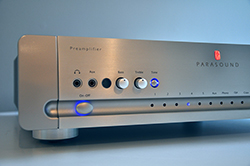
I have been fortunate to have Parasound gear in my reference system for many years, including the Parasound P 3 and the Parasound Halo A21 Amplifier. In fact I was in the process of reviewing the Thiel CS2.7 Floor-standing Speakers when the P 5 arrived.
As I mentioned, the P 5 does replace the P 3, so expect some comparison as I go along, but for the most part, the P 5 is another animal altogether and more akin to the upscale Halo JC line-up. Solid and well built, let’s get out of the way that its appearance is classic Halo; brushed silver faceplate, (available in black for those that have all black components). Halo saves some money by using metallic plated plastic end caps that remarkably look and feels like metal. Slightly sculptured faceplate with a slope actually is very functional, unless you stand at eye-level with your rack it does make it slightly easier to read. The functional aesthetics continue: while on standby mode, the glowing logo center top not only gets brighter when turned on but a blue glow appears around the on/off button and the input selected glows, easily seen in a darker setting – all nicely placed in a groove along the front panel.
To a P 3 owner the immediate design change is the omitted display which is more than aesthetic or marketing; the LED readout could introduce audio noise and interference, although frankly in all my years with the P 3, I never experienced such noise. The other significant feature P 3 owners would realize is the new volume control. The P 3 has a stepped attenuation that I always felt needed a few more notches in-between. The P 5 has a smooth “motor-driven Alps potentiometer volume control”.
Parasound places tone controls on the front panel and are noticeably active when a blue glow appears around the tone button. A variable gain auxiliary input is also on the front serviced by a 3.5mm jack for portable players. The manual suggests the gain stage will boost the input by 12dB keeping the volume at levels consistent with other components.
Aside from a balance and mute button, on the faceplate is the subwoofer level adjustment knob. I’ll discuss the bass options a bit later but this control offers an adjustment between -10 dB and + 10 dB.

Spinning the unit around, the rear of the P 5 is a control and connection dream. The analog inputs on the P5 include four independent RCA line level jacks and a fifth jack that is shared with balanced XLR jacks, one or the other. It’s not uncommon for most people to separate their two-channel setup from the home theater processor so the P 5 like the P 7 (and optionally on the JC 2), offers a theater bypass. Using line level inputs (only), the P 5 can be placed in-line to act as the preamp for two-channel listening and therefore ignoring the a/v processor’s preamp section and vice versa while watching or listening to surround sound through the pre/pro. Just keeping the P 5 off will automatically engage the bypass mode.
Audio outputs include both balanced and unbalanced for both left/right and for a subwoofer.
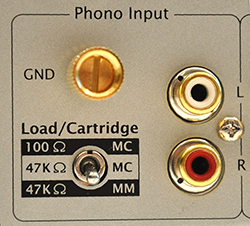
The P 5’s phono stage offers two load settings of 47 and 100 ohms for moving-magnet cartridges (MM cartridges)and 47 ohm for moving-coil cartridges ( MC cartridges).
Worth mentioning are the record out jacks and an IR for remote inputs including a loop output daisy-chaining to other components.
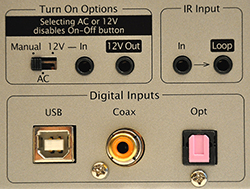
Where the P 5 becomes exceptional for me is offering digital inputs integrating a high-resolution 192kHz Burr-Brown DAC. The P 5 has digital inputs for coaxial, Toslink optical with sampling rates to 192 kHz and a USB input with sampling rates up to 96 kHz. Both my desktop PC and my Mac laptop easily found the P 5 as a playback device.
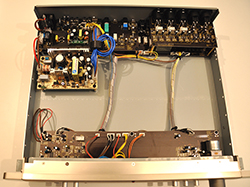
Removing the cover I’m amazed at the air in the chassis, this is a large box for the circuit boards and although they aren’t physically separated, the space between reduces the possible crosstalk or audio noise. But I’m impressed with the neat, clean layout, analog to one side, and digital to the other with the bass management in the middle.
Remote Control (subtitle)

The included remote has been simplified from the one included with the P 3. It’s actually a bit more ergonomic in feel and touch as well. I actually appreciate the simplicity of the remote but rarely use it other than for volume (mute) control. I suppose the other need from your chair would be the tone controls which the P 5 remote allows you to activate. Also, the remote does allow you to select inputs and the bypass feature. I wouldn’t but some might argue the remote doesn’t match the weighty presentation of the P 5 chassis, I couldn’t care less, spend the money in the component.
Bass Management (subtitle)
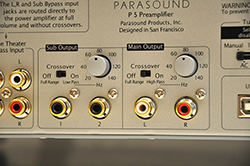
Felt this deserved its own heading. Parasound refers to the Halo P5 as a 2.1 channel preamplifier meaning it has bass management for two subwoofers. Low pass for subwoofers and high pass for main speaker’s crossovers are provided with variable settings from 20-140 Hz. Turning off the crossover completely will feed your speakers the full frequency range. While integrated in a theater or multi-channel system, activating the Bypass mode turns off the crossovers settings allowing your processor to handle the bass management.
Although the crossover frequency controls are on the rear, the subwoofer level knob on the front can fine tune your output.
Setup of the Parasound Halo P 5 Preamplifier
The features offered and options available on the P 5 are what really blow me away. Frankly I didn’t know where to begin, but the first connection was to my PC and Windows for High resolution files via the USB connection.
I use both a Marantz and an OPPO for disk playback. Although I almost exclusively use the Marantz to feed the preamp analog inputs, I had played with sending the raw digital signal to the P 5 via the optical connection to hear the P 5 handle the D/A conversion. Additionally I auditioned a Bluetooth player in the massfidelity Relay where I’m able to send the P 5 both an analog or digital signal. Options, options..
A Marantz turntable provides my vinyl listening.
Although I do not use separate subwoofers in my two-channel system, currently hooked up are the GoldenEar Triton 3’s which have powered subs built-in. To their credit, GoldenEar does give you a line level input if you want to bypass the rear gain control for the subwoofer, therefore I’m able to use the P 5’s bass management feature directly. This would also be a great way to connect say a pair of stand mounted monitors and separate subs for each channel. The P-5 does offer a balanced subwoofer output as well.
The Parasound A21 is my amplifier of choice and all cables including power, interconnects and speakers are from Clarus.
The Parasound Halo P 5 Preamplifier In Use
The P 3 always gave me a clean and quiet presentation, notwithstanding a little acceptable noise from the phono stage. The P 5 is no different, clean and clear. I sensed no loss or graininess at the high end or lack of extension at the bottom. What the P 5 does very well is offer a wide and deep soundstage, instruments and vocals nicely layered and a convincing openness and transparency.
The tonal quality reproducing instruments seemed spot on playing (flac) Kenny Burrell’s Midnight Blue. The opening track, Chitlins Con Carne features some seductive bongos before Kenny takes over with his electric guitar. The P 5 creates such an excellent ambience and stage presence placing the instruments where your ears (and eyes) can follow. The bongos always to the extreme left, while the drum kit to the right. Kenny’s guitar floats between the channels, clean and vibrant with excellent decay. Further evidence on the namesake track, Midnight Blue emphasizes the stand-up bass; the P 5 resolves the heavy and punchy bass that seems to come from all angles.
I’m a sucker for bossa nova music from the 60’s and 70’s and Stan Getz’s in particular. Somehow reminds me of an exotic trip to Brazil despite the fact that Stan was a Philly native, and I’ve never been to Brazil. His album The Best of Two Worlds (CD) features his saxophone with Brazilian guitarist and vocalist Joao Gilberto. The P 5 portrays the image on this studio recording as a rich and almost jazz-club intimate – when you can look and hear the instruments individually during a performance. The P 5 does a nice job tightening up the percussions.
Female voices showed no effects of sibilance and in fact I found female voices sounding rich with character and strength. The intimate Norah Jones, Live from Austin Tx (vinyl) recording offers her voice full and throaty, yet sweet and subtle. Even her piano sounded warm, and the notes well extended. Her duet with M. Ward and their rendition of Blue Bayou shows how clean and low the noise floor is on the P 5. The space around each voice and accompanied guitar is cleanly shaped.
For large scale, I played Mahler’s Symphony No. 8 and David Zinman with the Zurich Tonhalle Orchestra (SACD). I do love the enormous choral and I hoped the P-5 would decipher or resolve the grandness of this symphony. As an architect, I share the sense of “building” in this symphony, the sense of spirit and structure to this work. The P 5 simply allowed the recording to shine, the minor nuances of distant horns played well against the powerful forward strings.
I’m convinced of the Parasound ability to confidently handle the analog domain but in all fairness I felt it necessary to compare the digital circuitries with a couple of other DACs on hand, my own Benchmark DAC1-USB DAC and in for review an NAD D 1050 DAC. The NAD 1050 is newer and has been out less than a year. The Benchmark costs slightly more when it was new than the P 5 and the 1050 costs 50% less.
The Benchmark DAC has been my reference for some time. In terms of sound alone, it has always offered a smooth, non-fatiguing overall presentation and in my A-B-C comparison with the NAD and the internal DAC of the P 5 I found the Benchmark slightly more refined. Where the NAD offered a clean sound yet the slightest edge of graininess, the P 5 held its own, offered remarkably a more analog sound, a bit warmer and involving. Yet despite my long-time preference for the Benchmark, the Parasound performed so well, I could easily remove the Benchmark from the chain altogether or better yet, use the controls of the P 5 and use the Benchmark as an input device.
Searching my digital library I “cued” up Bob Dylan’s, Infidels (96/24 FLAC) pushing it from my PC through the USB input on the P 5. The Mark Knopfler influenced recording reveals a tightly controlled and polished presentation, the P 5 handles this rock music in a soulful way. Dylan’s voice is highlighted rather than masked, the clear guitars and shaped percussions work as an ensemble especially noticeable leading into the final track Don’t Fall Apart on Me Tonight. The P 5 beautifully floats Dylan’s opening harmonica with an airy echo.
Conclusions about the Parasound Halo P 5 Preamplifier
I laud Parasound and its effort with the updated and new P 5; to merely say it’s a bargain competing with preamps costing many times more is not giving it enough praise. It performs exceptionally well, quiet for a preamp, a low noise floor, balanced input/output, digital processing and bass management.
In one box you get all the analog and digital you need and there are very few preamps, DACs or combination(s) out there that the affordable P 5 stands out. The fact that it replaces up to four separates is more than just space saving, it’s smart in our economic climate, for me anyway. If DACs become more sophisticated and technology changes, the P 5 can still remain the controller.
My advice is simple, just get one, I recommend it strongly!



